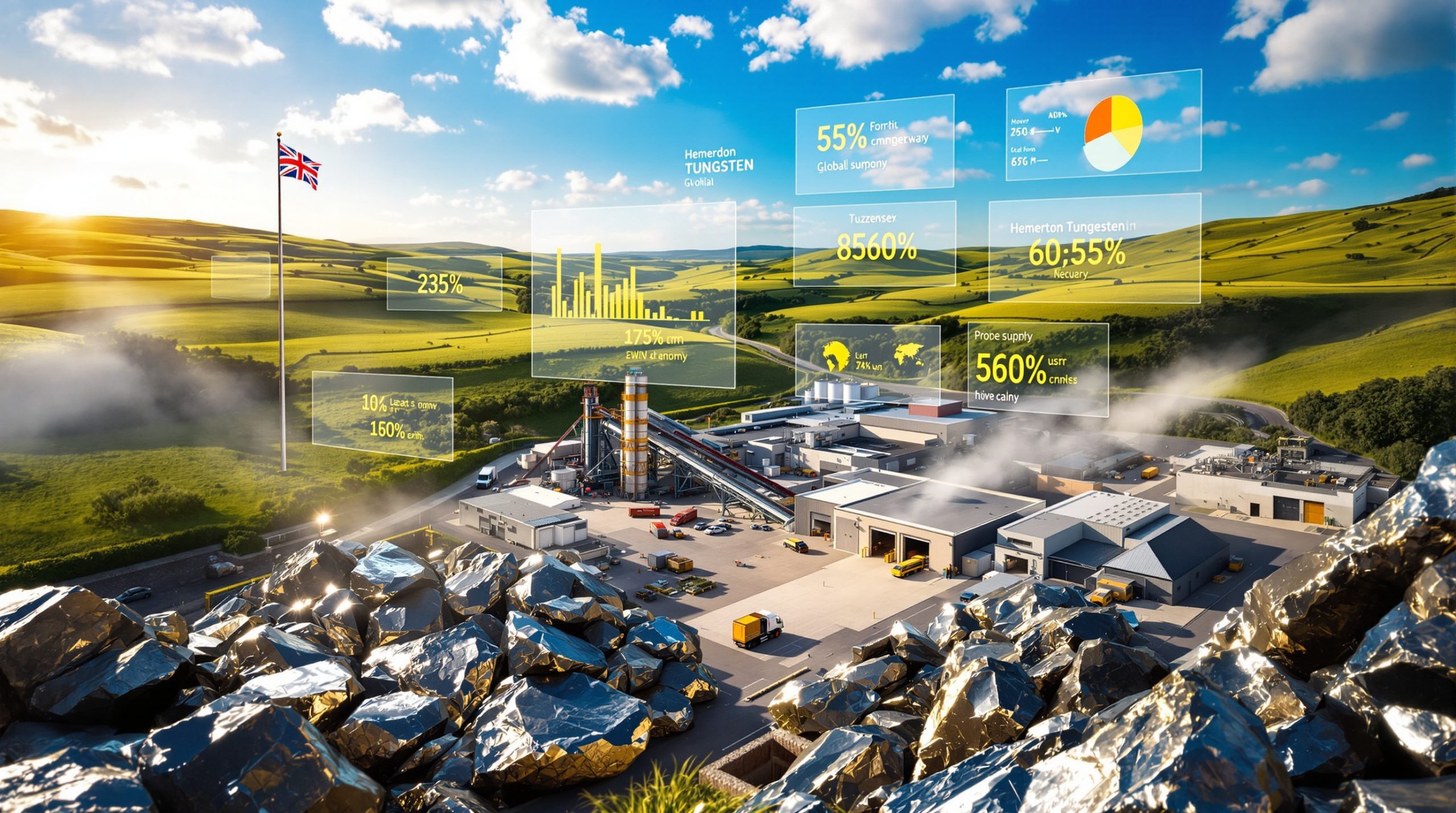Perseus Mining's five-year growth plan represents a comprehensive transformation strategy designed to elevate the company into the upper echelons of mid-tier African gold producers. The Perseus Mining five-year growth plan encompasses operational expansions, strategic capital investments, and systematic production scaling across multiple jurisdictions.
The strategic framework centers on achieving 2.6 to 2.7 million ounces of cumulative gold production through 2030, representing annual output targets of 515,000 to 535,000 ounces. This ambitious production increase builds upon Perseus's current operational foundation while maintaining target all-in sustaining costs between $1,400 to $1,500 per ounce. Moreover, current market conditions with historic gold price surge provide substantial margin enhancement for this expansion strategy.
Core Production Targets and Financial Framework
The growth strategy operates within a robust financial structure supported by Perseus's current $837 million net cash position. This substantial cash reserves enable debt-free growth funding for the entire $878 million development capital program through 2030.
Financial Structure Overview:
- Total development investment: $878 million
- Self-funding capability: $837 million current cash
- Debt-free growth approach: Zero external financing requirements
- Reserve backing: 93% of projected production supported by proven/probable reserves
The financial discipline underlying the Perseus Mining five-year growth plan eliminates dilution risks while preserving shareholder returns through concurrent buyback programs. This approach demonstrates management's commitment to balanced capital allocation between growth investment and immediate value creation.
What Makes Perseus Mining's Nyanzaga Project the Growth Plan's Cornerstone?
The Nyanzaga development in Tanzania emerges as the critical foundation for Perseus's production transformation, requiring approximately $523 million in capital investment and representing the largest single component of the five-year strategy.
Nyanzaga's strategic importance extends beyond immediate production contributions, positioning Tanzania as Perseus's fourth operational jurisdiction alongside established West African operations. The project timeline targets first production in Q1 2027, with construction progress demonstrating strong execution momentum.
Nyanzaga's Production Contribution and Development Timeline
Current construction activities indicate robust project advancement with over 1,000 workers deployed on site as of late 2025. Critical construction milestones include completed earthworks for processing facilities, advancing camp infrastructure with roofs installed on accommodation buildings, and mill fabrication proceeding ahead of schedule.
Nyanzaga Development Milestones:
- Capital requirement: $523 million
- Production contribution: 28% of five-year total output
- Timeline: Q1 2027 first production target
- Workforce deployment: 1,000+ personnel on site
- Schedule status: On-time, on-budget execution
The project's power infrastructure represents a critical development component, with contracts awarded for permanent power line installation and transformer deployment. This infrastructure investment supports long-term operational stability beyond the initial production ramp-up period.
Technical Execution and Resource Optimization
Ongoing exploration drilling at Nyanzaga has yielded promising results that could support potential reserve updates in 2025. These additional resource delineation efforts position the project as a long-term production anchor extending well beyond the current five-year planning horizon.
The construction approach employs multiple concurrent work streams including civil works, mechanical installation, and tailings facility development. Mill fabrication on the project's critical path maintains schedule buffers, providing contingency against potential delays.
How Will Existing Operations Support the Five-Year Production Goals?
Perseus's established mining operations across West Africa form the production backbone supporting growth targets, with each facility undergoing strategic transitions to optimize ore sources and extend operational life.
The three-operation platform spans Côte d'Ivoire (Yaouré and Sissingué) and Ghana (Edikan), providing geographic diversification within Perseus's core competency region. Each operation contributes specific production allocations while managing transitions to higher-grade ore sources.
Yaouré Mine's Production Evolution
The Yaouré operation represents the largest production contributor, targeting approximately 210,000 annual ounces over a projected 12-year mine life. The operation recently completed mining in the higher-grade CMA open pit and transitioned entirely to the Yaouré pit, which presents both geological complexity and initially lower grades.
| Yaouré Operation Details | Specifications |
|---|---|
| Annual production target | 210,000 ounces |
| Mine life projection | 12 years |
| Five-year contribution | ~33% of total output |
| Current transition | CMA pit to Yaouré pit |
To address the transitional challenges, Perseus has enhanced grade control and mining practices, with reconciliation data showing improvement trajectories toward expected performance levels. However, the initial lower grades from Yaouré pit represent a temporary production headwind before underground sources provide higher-grade ore access.
Edikan and Sissingué Production Allocations
Ghana's Edikan mine contributes approximately 28% of five-year gold output, with recent transitions from AG Pit and Fetish Pit to Nkosuo Pit positioning the operation for grade improvements in subsequent quarters. The mine faced access challenges and weather-related complications during the wet season, but repositioning to proper sequence during the dry season resolves these operational constraints.
The Sissingué complex in Côte d'Ivoire provides around 10% of total production through its integrated approach combining the Sissingué processing facility with satellite deposits. The operation currently processes ore from the Fimbiasso mine located 60 kilometers away while establishing mining at the Bagoé complex, specifically the Antoinette deposit.
Sissingué Production Enhancement Strategy:
- Processing hub: Sissingué facility
- Current ore source: Fimbiasso mine (60km distance)
- Next ore source: Antoinette deposit (Bagoé complex)
- Future development: Véronique deposit
- Expected benefit: Significantly higher grade ore feeding
The sequential development approach at Sissingué demonstrates systematic asset maximization through phased satellite deposit mining. Higher-grade Bagoé ore represents a near-term production uplift driver, with grade improvements expected to translate into increased quarterly output.
Which Underground Developments Will Drive Long-Term Value Creation?
Perseus's underground mining initiatives represent critical transitions from surface operations to deeper, higher-grade ore bodies that extend asset life and optimize long-term value creation.
The CMA Underground project at Yaouré constitutes Perseus's first underground mining operation, designed to access higher-grade ore sources beneath the completed CMA open pit. Initial development progress shows 69 meters completed by late October 2025, with favorable rock quality and cycle times exceeding expectations.
CMA Underground Technical Progress
The underground development commenced with the first portal blast during Q3 2025, marking the transition from surface to underground mining operations. Despite starting three months behind the original schedule, the project team pursues efficiency gains and design optimization to recover lost time.
CMA Underground Development Status:
- Development progress: 69 meters completed (late October 2025)
- Schedule position: 3-month delay with recovery efforts underway
- Rock quality assessment: Favorable conditions
- Cycle time performance: Exceeding expectations
- Strategic significance: Foundation for Yaouré life extension
The favorable geotechnical conditions support the underground mining approach, with strong rock quality enabling efficient development cycles. Design optimization efforts indicate potential for schedule recovery despite initial delays, maintaining the project's position as a critical long-term value driver.
Edikan Underground Development Potential
Similar underground opportunities at Edikan provide pathways for production growth and mine life extension beyond current surface operations. The strategy emphasizes leveraging existing infrastructure and processing facilities to maximize capital efficiency in underground expansion.
Underground development at existing operations represents a capital-efficient approach to production growth, utilizing established processing facilities, power infrastructure, and operational expertise while accessing deeper, potentially higher-grade ore bodies.
What Geographic Diversification Benefits Does the Plan Deliver?
The Perseus Mining five-year growth plan enhances operational geographic distribution across politically stable African mining jurisdictions, reducing single-country exposure while maintaining operational synergies within established regions.
The expanded footprint encompasses three countries: Côte d'Ivoire (Yaouré, Sissingué), Ghana (Edikan), and Tanzania (Nyanzaga), providing regulatory diversification while concentrating operations within Perseus's core African competency region.
Risk Mitigation Through Multi-Jurisdictional Operations
Operating across multiple West African jurisdictions provides regulatory diversification benefits while keeping operations within Perseus's established expertise area. This approach balances risk management with operational efficiency, avoiding the complexities of entering entirely new regional markets.
The strategic philosophy emphasizes building upon existing relationships, regulatory knowledge, and operational expertise rather than pursuing geographic expansion outside Africa. This disciplined approach reduces execution risk while maximizing operational leverage.
Infrastructure Leverage and Regional Expertise
The three-country operational platform leverages Perseus's established infrastructure investments, supply chain relationships, and regulatory expertise developed through years of African mining operations. This foundation reduces development risk and accelerates project execution timelines.
Geographic Distribution Benefits:
- Côte d'Ivoire: Two operations providing operational synergies
- Ghana: Established regulatory relationships and infrastructure
- Tanzania: Strategic expansion into East Africa
- Risk reduction: Multi-jurisdiction exposure mitigation
- Expertise leverage: Concentrated African mining competency
The geographic strategy reflects management's philosophy of leveraging competitive advantages rather than pursuing diversification for its own sake. This focused approach enables value creation through operational excellence rather than geographic complexity.
How Does Perseus Plan to Fund Growth Without Compromising Financial Strength?
Perseus's debt-free growth strategy represents a cornerstone of the five-year expansion plan, utilizing robust cash generation and existing reserves to fund all planned developments without external financing requirements.
The company's $837 million net cash and bullion position provides complete funding capability for the $878 million capital program, eliminating financing risk and interest expense burdens. This financial strength enables simultaneous growth investment and shareholder returns.
Cash Flow Generation and Capital Allocation
Current operations generate substantial quarterly cash flows, with Q3 2025 producing $161 million in operating cash flow from 100,000 ounces at $1,463 per ounce AISC. This consistent cash generation supports both capital investment and shareholder return programs.
The financial strategy maintains a $100 million buyback program while simultaneously funding expansion projects, demonstrating disciplined capital allocation that balances growth investment with immediate shareholder value creation. Furthermore, this approach aligns with gold market strategies emphasising value preservation.
Shareholder Return Balance
The growth funding approach preserves shareholder returns through concurrent buyback programs while advancing development projects. This balanced capital allocation demonstrates management's commitment to both growth and immediate value creation for shareholders.
Financial Strategy Framework:
- Self-funded growth: Operating cash flow and existing cash reserves
- Zero debt requirement: Complete internal funding capability
- Shareholder returns: Maintained through buyback programs
- Financial flexibility: Preserved for opportunistic acquisitions
- Interest expense: Eliminated through debt-free approach
The debt-free growth model provides financial flexibility for opportunistic acquisitions while maintaining the ability to weather commodity price volatility without leverage-related constraints.
What Production Milestones Will Mark Success Through 2030?
The Perseus Mining five-year growth plan establishes clear production benchmarks and operational milestones that demonstrate successful strategic execution through measurable performance indicators.
Production growth follows a structured timeline with existing operations maintaining baseline levels while Nyanzaga ramp-up provides incremental volume from 2027 onward. The combination targets consistent 500,000+ ounce annual production by the plan's completion.
Annual Production Trajectory Targets
The production scaling strategy phases growth through operational optimization and new development commissioning. Q3 2025 performance of 100,000 ounces quarterly production provides a baseline for measuring improvement as grade transitions complete and new operations commence.
Key performance milestones include successful completion of grade transitions at existing operations, Nyanzaga commissioning in Q1 2027, and CMA Underground production contribution. These milestones provide clear measurement points for strategic execution success.
Cost Management and Efficiency Improvements
Maintaining AISC targets between $1,400-$1,500 per ounce requires operational efficiency gains, processing optimization, and economies of scale across the expanded production base. Q3 2025 AISC of $1,463 per ounce demonstrates current performance within target ranges.
Production Milestone Framework:
- Baseline performance: 100,000 oz quarterly (Q3 2025)
- Annual targets: 515,000-535,000 ounces by 2030
- Cost maintenance: $1,400-$1,500 per ounce AISC
- Nyanzaga contribution: 28% of five-year total from 2027
- Underground transition: CMA development supporting long-term growth
The milestone structure provides measurable benchmarks for investor assessment of strategic execution, with quarterly reporting enabling performance tracking against established targets.
Which Exploration Programs Support Future Growth Beyond 2030?
Perseus's growth strategy incorporates comprehensive gold exploration insights designed to extend mine lives, increase reserves, and identify development opportunities within existing operational areas.
Active drilling programs at all operations focus on converting resources to reserves while identifying additional mineralization that could support production beyond the current five-year planning horizon. These exploration investments represent critical inputs for sustainable long-term growth.
Resource Extension and Reserve Replacement
Ongoing drilling at Nyanzaga has yielded promising results, with potential reserve updates planned for later in 2025. These resource extension programs position projects as foundation assets extending well beyond initial development timelines.
The exploration philosophy emphasizes extending existing asset lives rather than pursuing greenfield opportunities, leveraging established infrastructure and operational expertise to maximize capital efficiency.
Satellite Deposit Development Opportunities
The strategy includes systematic evaluation of satellite deposits near existing operations, utilizing established infrastructure to develop smaller ore bodies cost-effectively. The Sissingué complex exemplifies this approach through sequential development of Antoinette and Véronique deposits.
Exploration Program Components:
- Reserve replacement: Converting resources to proven/probable reserves
- Mine life extension: Identifying additional mineralization
- Satellite development: Leveraging existing infrastructure
- Resource optimization: Systematic deposit evaluation
- Infrastructure leverage: Maximizing existing facility utilization
This focused exploration approach reduces capital requirements while increasing reserve confidence, supporting long-term production sustainability beyond the immediate five-year growth period.
How Will Market Conditions Impact Growth Plan Execution?
The Perseus Mining five-year growth plan incorporates various gold price analysis scenarios and market condition assessments that could influence project economics, development timing, and capital allocation priorities.
Current gold prices above $4,000 per ounce provide substantial margin enhancement, with production costs of $1,463 per ounce AISC generating significant cash flow for growth funding. However, the strategy maintains economic viability across multiple price environments.
Gold Price Sensitivity Analysis
Production targets and cost structures provide robust economics across varying gold price scenarios. Higher prices accelerate development timelines and enhance project returns, while lower prices may defer non-critical expansions without compromising core production targets.
The hedging strategy employs zero-cost collars and put options to maintain downside protection while maximizing upside exposure as committed hedges expire. This approach balances risk management with gold price participation.
Supply Chain and Labor Market Considerations
The execution strategy incorporates lessons learned from recent global supply chain disruptions and skilled labor availability challenges. Construction progress at Nyanzaga with 1,000+ workers on site demonstrates successful workforce deployment despite market constraints.
Market Condition Factors:
- Gold price sensitivity: Economic viability across price scenarios
- Supply chain resilience: Contingencies for equipment delivery
- Labor availability: Skilled workforce deployment strategies
- Currency exposure: Multi-jurisdiction foreign exchange risks
- Regulatory environment: Political stability assessments
The market condition analysis supports strategic flexibility while maintaining core production commitments across various economic scenarios. Additionally, understanding global gold production trends helps inform Perseus's positioning within the broader industry landscape.
What Risks Could Challenge the Five-Year Growth Strategy?
Despite comprehensive planning and strong execution capabilities, several risk factors could potentially impact successful achievement of Perseus's ambitious production and development targets.
Underground development complexity represents the primary technical risk, with CMA Underground marking Perseus's first foray into underground mining operations. While initial rock quality assessments prove favorable, underground mining introduces operational complexity beyond surface operations.
Operational and Technical Risks
Technical execution challenges include geological uncertainty in underground development, processing optimization for varying ore sources, and integration complexity across multiple concurrent projects. The three-month delay in CMA Underground development illustrates potential schedule risks despite favorable conditions.
Grade transitions at existing operations present reconciliation challenges, as evidenced by Yaouré's transition from higher-grade CMA pit to the more geologically complex Yaouré pit. These transitions require enhanced grade control and mining optimization.
Regulatory and Political Considerations
Operating across multiple African jurisdictions exposes Perseus to regulatory changes, tax policy modifications, or political instability that could impact operations or development approvals. However, the company's established relationships and operational history provide mitigation benefits.
Primary Risk Categories:
- Technical execution: Underground development complexity
- Geological uncertainty: Resource/reserve reconciliation variations
- Regulatory changes: Multi-jurisdiction policy modifications
- Market volatility: Gold price and currency fluctuations
- Supply chain disruptions: Equipment and material delivery delays
- Labor constraints: Skilled workforce availability challenges
Risk Mitigation Disclaimer: The Perseus Mining five-year growth plan involves forward-looking projections subject to various operational, market, and regulatory risks that could materially impact actual results compared to stated targets.
Frequently Asked Questions About Perseus Mining's Growth Plan
What makes Perseus's growth plan different from competitors?
Perseus's strategy emphasises debt-free organic growth through self-funding, with $837 million cash supporting $878 million capital requirements without external financing. This approach eliminates dilution risks while maintaining financial flexibility for opportunistic acquisitions within the African gold sector.
When will investors see production increases from the growth plan?
Significant production increases begin with Nyanzaga commissioning in Q1 2027, contributing 28% of five-year total production. Existing operations provide steady growth through grade improvements at Edikan (Nkosuo pit) and Sissingué (Bagoé/Antoinette ore), while CMA Underground extends Yaouré's productive life.
How does the plan address environmental and social responsibilities?
The strategy incorporates sustainable mining practices, community engagement programmes, and environmental management systems consistent with international standards. Perseus's industry-leading 6.0 TRIFR safety performance demonstrates commitment to operational excellence and worker safety across all jurisdictions.
What happens if gold prices decline significantly during the plan period?
The robust cost structure with $1,463 per ounce AISC and high-grade ore sources provide economic resilience across various price scenarios. The company maintains flexibility to defer non-critical developments while preserving core production targets, supported by the debt-free financial structure.
Can Perseus fund its complete growth program without additional financing?
Yes, the $837 million net cash position combined with strong operating cash flow ($161 million quarterly) provides complete funding capability for the $878 million five-year capital programme. This self-funding approach eliminates equity dilution and debt-related constraints while supporting concurrent shareholder returns.
What exploration upside exists beyond the current five-year plan?
Active drilling programmes at all operations focus on extending mine lives and reserve replacement, with Nyanzaga showing promising results for potential reserve updates in 2025. Satellite deposit development opportunities near existing operations provide organic growth potential leveraging established infrastructure investments.
External resources such as Perseus Mining's official production guidance announcement provide additional insights into the strategic implementation timeline. Furthermore, Mining Weekly's coverage offers independent analysis of Perseus's growth trajectory positioning within the broader African gold mining sector.
Looking to Capitalise on Africa's Growing Gold Production Potential?
Perseus Mining's strategic expansion demonstrates the substantial opportunities emerging across African gold mining operations. Discovery Alert's proprietary Discovery IQ model delivers real-time alerts on significant ASX mineral discoveries, instantly empowering subscribers to identify actionable opportunities ahead of the broader market and begin your 30-day free trial today to secure your market-leading advantage.




